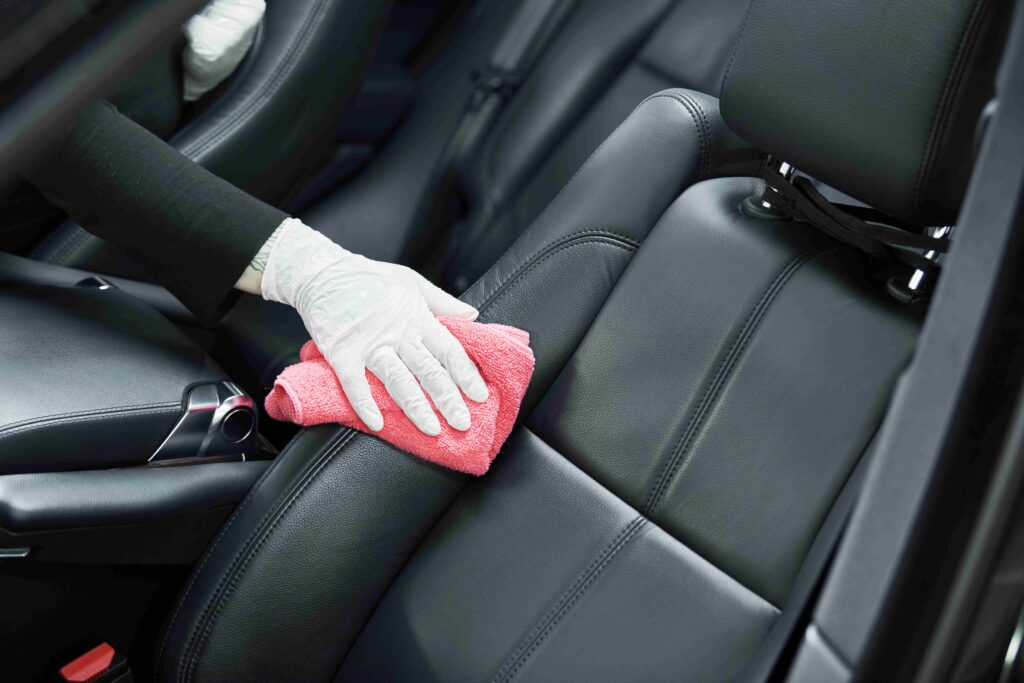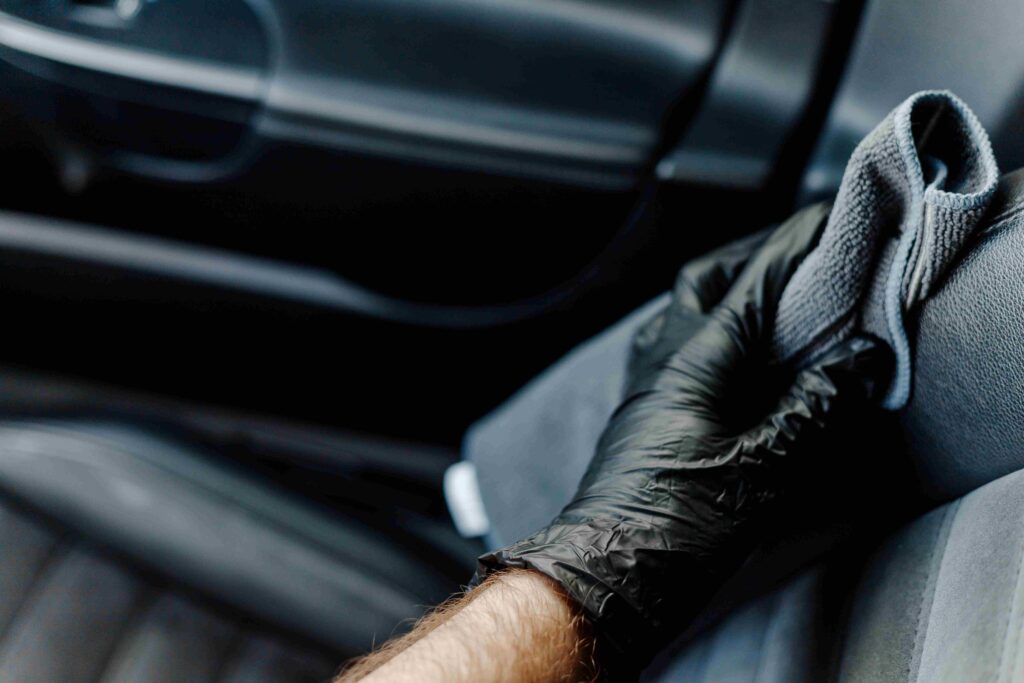How to Clean Leather Car Seats
Many car owners prefer leather car seats because of its luxurious and comfortable appearance. When neglected, though, it can be susceptible to damage like scratches and stains. Car owners must stay informed on how to clean leather car seats to keep it in the best condition and your car interior looking luxurious for years.
This guide provides comprehensive tips on how to clean leather car seats and the best cleaning products to avoid damage.
Actionable Steps
• Use proper cleaning products and tools to clean leather car seats while preventing damage like scratches and stains.
• Always test your cleaning products on a hidden portion of the seats before applying the entire solution.
• The ideal cleaning frequency for leather car seats would be one to three months, depending on the extent of damage.
• Choose the right cleaning products for leather and refer to the manufacturer’s recommendations.

What You Need to Clean Leather Car Seats
You need the following products and tools to clean leather car seats:
• Vacuum with a soft brush
• Microfiber towels
• Automotive leather cleaners
• Automotive leather conditioners
• Water
• Moisturizing soap
How to Clean Leather Car Seats: Detailed Guide
Cleaning car leather seats can be an intimidating process, especially if it’s your first time doing this. Don’t fret because it’s actually easier than you think. Follow this step-by-step guide on how to clean leather car seats to give your car interior the royal treatment it deserves and to ensure a comfortable ride.
Step 1: Remove large debris.
If you have a child in your car, chances are there will be plenty of debris in the car seats. Take time to remove these debris and other objects that might be stuck in between the car seats before you begin the actual process of cleaning the car seats. Remove the car seats that are installed in the chairs to be able to see any debris they have left behind.
Step 2: Vacuum the seats.
Now that you’ve removed the large debris, it’s time to start vacuuming. Using a vacuum can help get rid of the pesky grime and dirt that you missed during the initial sweep. If your vacuum comes with a brush attachment, use it to help gouge any debris or dirt in between the leather seats. But, make sure it is a soft bristled brush so you don’t scratch on the leather seats. Make sure you get in between the cracks and crevices to pick up all the extra dirt.
If you see any other dirt, you can wipe it down with a microfiber towel.
Step 3: Test your cleaning solution first.
Before you apply the leather cleaner to the seats, make sure to test it a hidden location first. Do this step no matter if you’re new to using this particular leather cleaner or not. The last thing you want is to accidentally ruin your leather car seats. If you see signs of melting or fizzing on the leather material, it’s a sign that you should not proceed with using that particular cleaning solution.
If you’re confused, check the owner’s manual for specific recommendations on cleaning products and solutions. And always err on the side of caution and choose gentle cleaning solutions rather than harsh ones.
Step 4: Apply cleaning solution and wipe with microfiber towel.
Apply the leather cleaner to the seats. It helps absorb any sticky grimes and dirt that the vacuum might have missed. Be careful not to apply too much of the product. Ideally, work in small sections to ensure a deep clean and that you don’t miss any spot. Also, it would be best if you apply the leather cleaner solution on the cloth and use it to wipe the seats instead of applying it directly to the leather material.
Once you apply the leather cleaner, you should wipe it down with a microfiber towel. Make sure that the cloth is damp and avoid using too much water. If there is excess moisture, it can cause staining on the leather seats. That’s why we recommend wiping it twice with a microfiber towel to ensure it is completely dry.
Step 5: Apply a leather conditioner.

Using a leather conditioner is recommended to complement your cleaning routine for car leather seats. This product improves the longevity of the leather car seat material, but also prevents cracks or tears on the surface. If you want your leather to look brand new for much longer, then it is highly recommended you use automative leather conditioners as part of the cleaning routine.
Apply the conditioner in a circular motion and then work it into the seats to ensure they are fully absorbed. Once applied, let it sit for at least ten minutes. After the ten minutes is over, use a microfiber towel to pat the seats dry and remove any excess product.
Step 6: Air Dry the Seats
Wait for at least an hour after you’re done cleaning before using your car again. But, if possible, let the conditioner sit for up to four hours.
Additional Leather Car Seat Cleaning Tips
Below are additional reminders if you want your leather car seats to look their best:
• Give the cleaning products a time to be absorbed and work. Don’t wipe them off right away, but don’t leave them on for too long either.
• When cleaning hard-to-remove stains, always be gentle and use only approved cleaning products for leather upholstery. Refrain from scrubbing them too hard with an abrasive cleaning tool.
• Wipe away spills as soon as they occur so you don’t give time for the liquid product to be absorbed into the leather material.
• Use protective substances on your leather car seats, especially when it comes to UV protection. A leather conditioner can protect against UV rays and helps prevent fading.
• Even if it’s not yet time to clean the car seats, make it a habit to vacuum the seats to eliminate any debris that might accumulate.
• Use seat covers. It is especially useful when you have pets or children as the seat covers can protect the leather material from damage.
Giving your car parts and accessories, such as leather car seats, is the best way to maximize your extended car warranty. This type of warranty coverage could cover accessories, including car seat damage. Hence, it is essential to invest in proper care and maintenance to enjoy the perks and benefits of the warranty.
How Often to Clean Leather Car Seats
It depends on the amount of dirt and grime you are dealing with on your leather seats. For example, if you have children or pet in your car most of the time, you should clean it more frequently than if you drive the car without children or pets.
The ideal frequency when cleaning leather car seats would be one to three months. Experts suggest cleaning it once a month and conditioning the leather seats once every three months.
Following this recommendation when cleaning and conditioning your car leather seats would help retain its quality for longer.
DIY Methods to Clean Leather Car Seats
Using products at home can also be a cost-effective way of cleaning leather car seats.
Vinegar and Water
Mixing equal parts vinegar and water is an effective solution for cleaning leather car seats. Apply a small amount onto a microfiber towel and use it to wipe the leather upholstery using a circular motion. This solution lifts any dirt from the leather surface.
Lemon Juice and Cream of Tartar
Using the lemon juice and cream of tartar solution is only applicable when cleaning light colored leather seats due to the bleaching effect. Combine equal parts lemon juice and cream of tartar to form a paste. Apply the cleaning paste to the soiled part of the leather car seat and wait for 30 minutes before removing it. Wipe thoroughly.
Toothpaste
Use a non-gel toothpaste and dab it onto any soiled portion of the leather car seat. Use a soft-bristled toothbrush to gently scrub on the leather surface and remove stains. After scrubbing, wipe it with a towel and pat dry.
Baking Soda
Using baking soda is effective against oil and grease stains on leather car seats. Sprinkle a small amount and rub it on the leather seats using a damp cloth. The baking soda will absorb the excess oil. Use a soft towel to wipe off the baking soda.
Do’s and Don’ts When Caring for Leather Car Seats

Taking preventive measures to care for car leather seats is a better approach than learning how to clean leather seats. If you can minimize damage to your car seats, it can stay in pristine condition for longer.
Follow these do’s and don’ts guide when caring for leather car seats.
Do’s
• Spot test cleaning products before you apply them to the car seats.
• Vacuum the seats first to get rid of large debris and so you don’t end up scratching the leather surface when cleaning.
• Use a microfiber cloth as it is gentle enough to clean the leather without damaging it.
• Work at small sections to ensure a thorough clean and excessive moisture.
• Clean your leather car seats regularly to avoid accumulation of dirt and grime.
Don’ts
• Do not apply products directly to the leather car seat. Apply the solution to a towel and use the towel to wipe it clean.
• Do not use towel that is soaking wet. A damp towel will do the job.
• Do not apply too much product to avoid product buildup on the leather surface.
• Do not use a hard bristled brush when cleaning the leather or it could cause damage like scratches.
Tips for Choosing Cleaning Products for Leather Seats
If you’re using cleaning products for your leather seats, it’s important to make the right choice as inappropriate products can cause damage. Here are important tips to consider when choosing your cleaning products:
• Check the owner’s manual to determine the recommended cleaning products and solutions for the leather seats. Double-check that the product is designed for leather upholstery.
• Avoid products containing harsh chemicals as they can strip away the natural oils from the leather, causing your car seats to look dull or become prone to cracking.
• Always use the most gentle cleaning formula you can find and adjust the use depending on the extent of stain you’re dealing with.
• If you have pets, make sure to avoid citrus-based solutions or wipe them thoroughly after applying the cleaning solution. Citrus can be toxic to some pets.
You may check this comprehensive guide on choosing the best automotive leather cleaners for your car.
Conclusion
The best approach when you want to know how to clean leather car seats is to start gentle. Then, gradually move on to more aggressive cleaning approaches if your seats need it.
You can always refer to your manufacturer’s recommendation on the best cleaning product that is suited for the type of leather that you’re working with. With a regular cleaning schedule, you can keep your leather car seats in the best condition for years to come.
FAQs
What not to use on leather car seats?
Avoid using cleaning products on leather car seats containing petroleum or waxes. These cleaning products cause buildup that could dull the leather finish, if not damage it over time.
How frequently should I clean my leather car seats?
The ideal interval for cleaning leather car seats is one to three months, depending on how dirty the car seat is.
Is vinegar safe on car leather?
Yes, but be careful when preparing the vinegar solution as too much vinegar can dry out the leather material. Let the vinegar solution sit for five minutes before wiping it.




